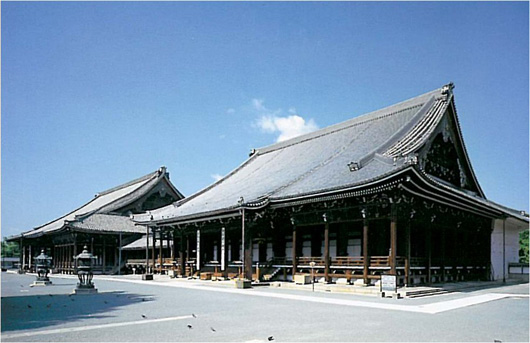History of Shin Buddhism

The Hongwanji is the main temple of the Jōdo Shinshū in Kyōto. (Hongwanji is an archaic transliteration of the name. Recently one can often read the modern transliteration Honganji.)
Only a few of Shinran’s followers lived originally in Kyōto. But over the years Shinran’s family established sucessfully Shinran’s mausoleum as a place of pilgrimage and finally as an important temple. Shinran’s daughter Kakushin-ni was the first “caretaker of the mausoleum”(rusushiki), and her sucessors in this position became the head priests of Hongwanji (the so-called Monshu). Even the present (25th) Monshu is a direct descendant of Shinran Shōnin.
It is thanks to the 8th Monshu, Rennyo Shōnin (1415-1499), that Shin Buddhism rised to the biggest Buddhist denomination in Japan. Rennyo was a gifted letter writer and motivator, who steered Jōdo Shinshū safely through one of the darkest ages of Japanese history.
After the Hongwanji had been repeatedly the victim of armed attacks by the monks of other denominations, Rennyo decided to build a temple with fortification on a strategically expedient place (where now the Ōsaka castle is located). For many decades this so-called Ishiyama Hongwanji was a factor of power in Japan. In the 1580ties, when the Hiei-zan monastery was devastated by the brute warlord Oda Nobunaga and thousands of monks were killed, the Ishiyama Hongwanji defied his siege for ten years. Finally the warring parties entered an agreement which granted a safe passage for the defenders, but the Ishiyama Hongwanji was razed to the ground.
This soft solution was not accepted by everybody without critizism. Kyōnyo, the oldest son of the Monshu Kennyo, had been an uncompromising supporter of the continuation of the siege, and therefore had been disinherited by his father. After Kennyo’s death the newly established Tokugawa Shogunate used this conflict within the founder’s family to devide the Jōdo Shinshū by presenting Kyōnyo his own main temple, which is now the Eastern Hongwanji (Higashi Hongwanji).
Although the schism of Jōdo Shinshū had only political reasons, which are obsolete since hundreds of years, it has never been overcome. Both temples are located in the north of Kyōto central station, and are only two kilometers away from each other. At the first glance they look, at least for the Western visitor, quite similar. But a more thorough look into the details reveals many differences f.e. in the liturgy. Furthermore both temples have established their own academical traditions: The Ryūkoku Universtity belongs to the Western Hongwanji (Nishi Hongwanji), while the Ōtani University is under the patronage of the Eastern Hongwanji.